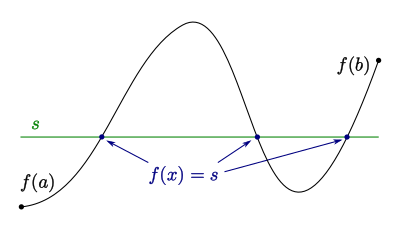Math for Non-Geeks/ Intermediate value theorem
{{#invoke:Math for Non-Geeks/Seite|oben}}
The intermediate value theorem says that every continuous function attains every value between and at least once. Continuous functions reach every intermediate value between and (if there are no holes in the domain between and ). So the intermediate value theorem can be used to determine the existence of functional values.
Motivation
File:Zwischenwertsatz-lernvideokurs-wa2018.webm Let be an arbitrary continuous function. At the point , it has the functional value and at the point it has the functional value . Let us assume that . Furthermore, let be an arbitrary value between and , meaning :
By our current perception, continuous functions don't have any jumps in their domain. Since is defined on the entire interval and its domain is connected, the graph binds the points and without jumps. If we bind and without "taking our pencil off the paper," at some point we must cross the line . So there is at least one point of intersection between the line and the graph of :
For the -values of the points of intersection it holds . The intermediate value is therefore attained once by the function . We have intuitively seen that continuous functions attain all values between any two functional values at least once, provided the domain doesn't contain any gaps between the two arguments.
The Intermediate Value Theorem
File:Zwischenwertsatz - Quatematik.webm Math for Non-Geeks: Template:Satz
Bolzano's Root Theorem
For the proof of the intermediate value theorem, it suffices to prove this for the special case . This special case is also called "Bolzano's Root Theorem." Math for Non-Geeks: Template:Satz
Why is it sufficient to only consider this special case? Let's take a function and a value between the functional values and . By the intermediate value theorem, we have to find a with . Now it holds:
Therefore if and only if . Now we will define the helping function with . As we've already determined, the equation is satisfied precisely in the case . So if we find a root of , then the function also attains the value .
Now the function fulfills all of the requirements to use Bolzano's Root Theorem. It's a function of the form with the closed interval as its domain. As a concatenation of continuous functions, the function is continuous. In the case it holds:
Using we can deduce the chain of inequalities . Now if we consider the case :
Altogether we can concude that zero is an intermediate value of and . Therefore satisfies the requirements for Bolzano's Root Theorem. By this root theorem there exists a with . For this it holds . This shows that the general intermediate value theorem can be easily deduced from Bolzano's root theorem. So now we must only prove Bolzano's theorem.
Proof of Bolzano's Root Theorem
Math for Non-Geeks: Template:Beweis
Corollaries of the Intermediate Value Theorem
Continuous functions map intervals to intervals Template:Anchor
With the help of the intermediate value theorem we can prove that continuous functions map intervals to intervals.
Math for Non-Geeks: Template:Satz
Range of Power Functions
Math for Non-Geeks: Template:Beispiel
Range of the Exponential Function
Math for Non-Geeks: Template:Beispiel
Math for Non-Geeks: Template:Aufgabe
Exercise: Fixed-point theorem
Proof of a Fixed-point Theorem
In the following exercise we will prove a fixed-point theorem. Fixed points are arguments of a function that satisfy the equation . In a sentence: fixed points are those points not changed by a function transformation. Fixed point theorems are therefore theorems, that prove the existence of fixed points in certain situations. For mathematics, such theorems are important because sometimes we can reduce the problem of proving the existence of a certain object to proving the existence of a fixed point. For example, the argument is a root of the function , if and only if the function with the ordering has a fixed point. Using the existence of a fixed point of the function , we can prove the existence of a root for . In the following exercise we are going to prove a kind of intermediate value theorem:
Math for Non-Geeks: Template:Aufgabe
Assumptions of the Fixed Point Theorem
In the fixed point theorem above, the continuity is a necessary condition of the proven theorem. If we leave this condition out, we can find a function for which this theorem is no longer true. This will be shown in the following exercise:
Math for Non-Geeks: Template:Aufgabe
Exercise: Roots and Range of Polynomials
Roots of Polynomials
The following exercise exemplifies a special case of the fundamental theorem of algebra. This theorem says that a non-constant polynomial
with complex coefficients has at least one complex root. In the real case this claim does not hold in general. A polynomial with real coefficients need not necessarily have real roots. A polyomial function without real roots could be, for example, . For certain polynomials, we can still prove the existence of a root:
Math for Non-Geeks: Template:Aufgabe
Range of Polynomials
Math for Non-Geeks: Template:Aufgabe
Exercise: The existence of n-th order Roots
The intermediate value theorem also offers a possibility to check the existence of -th order roots. In the chapter "Wurzel reeller Zahlen“ we have already proven this using the concept of nested intervals. Now we will see an alternative proof that uses the intermediate value theorem. Just a reminder: the -th order root for some positive number is a real number with .
Math for Non-Geeks: Template:Aufgabe
Exercise: Solving an Equation
Both the intermediate value and root theorems can be used to justify the existence of a solution of a given equation. The equation is used to build a continuous function, on which we can apply either the root theorem or the intermediate value theorem.
Math for Non-Geeks: Template:Aufgabe
{{#invoke:Math for Non-Geeks/Seite|unten}}

